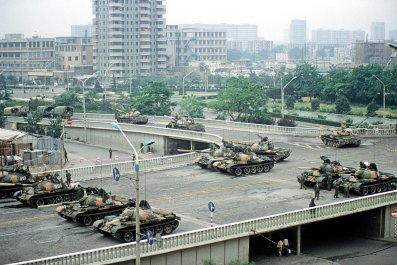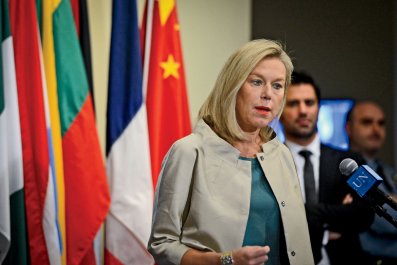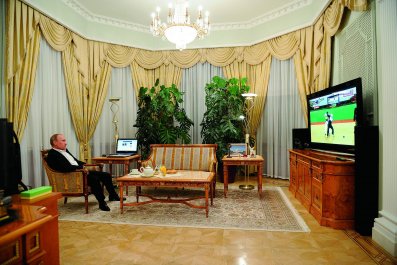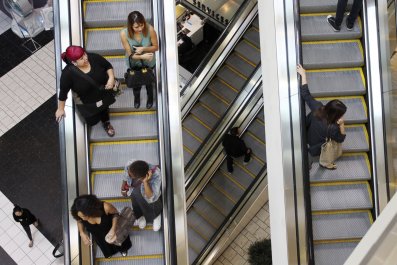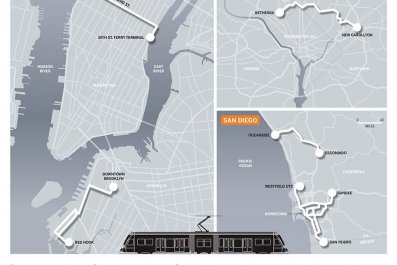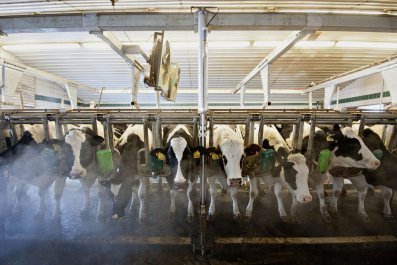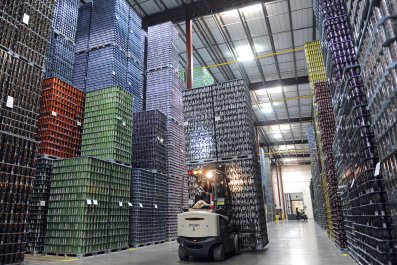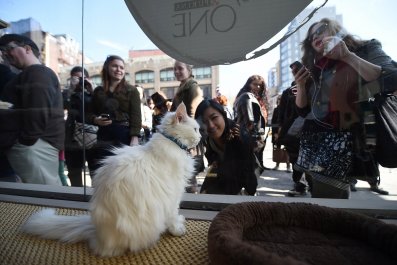The scale of the Syrian tragedy is immense. The story is often reduced to numbers: deaths, refugees, sick and wounded. Behind these figures are real people. Rabab Sabbagh, an early revolutionary from Homs, is relatively privileged; she has a job and lives in a proper building.
Rabab lives with her teenage son and daughter in a large room in an abandoned shopping mall, near Tripoli in north Lebanon, alongside 150 other Syrian families. Some, like her, paid rent while others squatted. The complex looks as though it was built in the 1960s, with generous spaces and wide walkways, across which dozens of children run around, seemingly oblivious to their families' tragic circumstances.
Rabab's room is a haven amidst the chaos, neat and calm with a curtain dividing her living space from the kitchen. Long benches are against two walls and a modern Persian carpet covers the floor. There's TV and an Internet connection, and a revolutionary flag to remind her of home. Rabab invited me to lunch as soon as I explained over the telephone my interest in finding out how the displacement of Syrian women was affecting the way they fed their families and whether they still cooked the same way they did back home.
Food was an integral part of life in Syria, as in the rest of the Middle East, and much of family life revolved around meals. It was in the kitchen that culinary lore was transmitted from mother to daughter. A typical Syrian meal included a salad, a dip or two, and a main dish, usually chicken or lamb cooked with vegetables or rice. In Aleppo, the gastronomic capital of the Middle East, meat was also cooked with such seasonal fruit as quince or sour cherries for intriguing sweet and sour combinations.
Rabab was peeling small aubergines, in stripes leaving some peel on, before cutting them in half, lengthways. She then made a slit in the middle of the fat part of each half, explaining that this helped them cook through. She cooked potatoes every day and made sure to buy her supply at the beginning of the month to avoid any shortage. She, and almost all of the refugees, relied on assistance from World Food Programme to buy their food. Initially, the programme distributed food parcels but these only contained dried goods and so they developed a credit card system redeemable in select shops (320 throughout Lebanon), with an allowance of $30 per person per month. Laure Chadraoui, the programme's senior communication officer, explained that the $1 a day was calculated to provide the necessary 2200 calories a person needs for good nutrition.
Eating for nutrition is one thing and eating for pleasure and memory is another. The allowance was enough for Rabab to feed her family, but not for them to eat the way they did back home. The meal she served was meatless -- here she could only afford to buy it for a few days at the beginning of each month. She had also prepared fattoush, a salad of bread and fresh herbs, using fewer herbs than she would at home, and seasoned some hummus from a can. There was plenty of bread, of course. Bread is the base of any Syrian meal but for refugees it has become essential because it's cheap and nourishing.
The day before meeting Rabab, I had driven up to Zahlé, north east of Beirut near the border with Syria, where I met Umm Ahmad (meaning the mother of Ahmad, though Ahmad is not her son's real name). A typical Syrian matriarch, she presides over her large family in a large wooden shack that her son, who worked at a nearby butcher shop, had cobbled together, protected from the rain by plastic sheeting provided by UNHCR. All refugees need to register with the United Nations High Commissioner for Refugees before they qualify for any assistance. Umm Ahmad's family had fled their home in the countryside outside Idlib, near Aleppo, a year ago and they had reproduced it inside the shack, with bright long rectangular cushions laid on the floor, and against the walls. Ahmad had set up a fully functional kitchen, rigging in electricity from a nearby pylon so as not to pay for it— most Syrian refugees I met got their electricity in the same way.
Umm Ahmad offered me muhallabiyeh (milk pudding) made with powdered milk, and without the traditional orange blossom, rose water or mastic. She also offered kibbeh, one of Syria's national dishes made by mixing minced meat with bulgur wheat; hers was made with potatoes. Her son may have been working at a butcher shop with more access to meat than other refugees but he still had to buy it and they couldn't afford to eat it daily.
Rabab's and Umm Ahmad's diet may have been modest, but it was fairly healthy compared to Safia Hussein's, who lives with her husband and eight children, one of them a newborn, in Na'meh, a dusty town south of Beirut. Her husband preferred to spend money on rent, to shelter his young children and wife, than on food and all Safia had in her fridge was bread, oil and za'tar (a herb and seeds mix), which they ate almost every day. Safia reminisced about whole lambs cooked for family gatherings or feast days back in their home in Qamishli, north east of Damascus, and how she was finding it difficult to adapt to her circumstances.
Sitting with Rabab, sharing her thrifty food, brought back memories of my many trips to Syria, in particular those days I spent in Aleppo, getting lost in the labyrinthine lanes of the medieval souks that are mostly destroyed now, stopping to talk to ladies like her, or Safia, or Umm Ahmad. The hospitality was the same but the food wasn't; Syria's rich culinary heritage is in danger of being lost like much else in this beautiful country.





